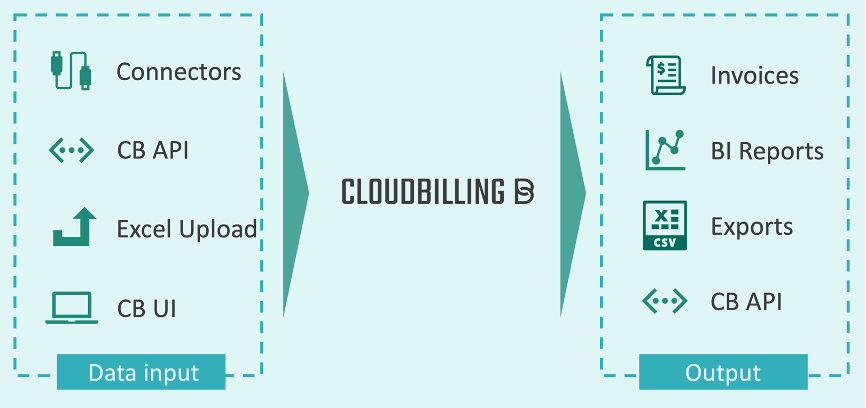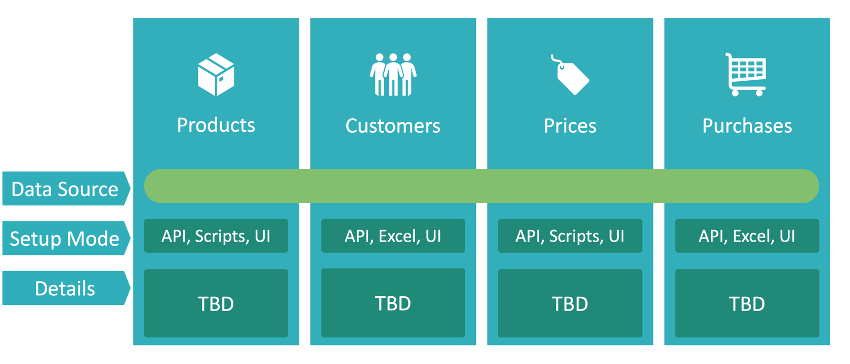Introduction
Welcome to the CloudBilling User guide. This is the online user guide containing the usage guidelines for the CloudBilling environment and is meant to provide documentation to people who work with the CloudBilling platform. The guide will provide information regarding the configuration and the usage of the CloudBilling platform.
This documentation is an addition to the training that will be given to new users of the CloudBilling platform. If this documentation does not answer your question(s), additional questions and requests can be sent to support@cloudbilling.nl via email or send in a ticket through our support system on support.cloudbilling.nl.
This Chapter will further explain CloudBilling as a platform , the basic principles , the business intelligence portals, and the structure of the documentation.
What is CloudBilling?
CloudBilling is a semi-automatic, flexible invoicing environment. As a complete SaaS-solution, CloudBilling provides her customers with the ability to implement complex billing constructions. This allows for a complete overview of the billing process and the implementation of complex billing structures.
The platform works with different types of pricing rules, which allows the user to tailor their environment to their specific wishes. Additionally, the platform allows for connections with existing product platforms, CRM systems, and accounting systems. In combination with connections through connectors with Cloud services like AWS or CSP, CloudBilling can collect all necessary information for the most complete and easy real-time invoicing.
The configuration of customers, products and prices is a one-time configuration, but can be changed when required. This allows for automatic invoicing and the possibility to scale-up smoothly. Combined with Business Intelligence and Customer Portals, CloudBilling offers a scalable solution to optimise the order-to-cash process.
CloudBilling: The basic principles
The basic principles of CloudBilling are described as the CloudBilling Ecosystem and the CloudBilling entities (or “Input”) shown in Figure Introduction 1 and Figure Introduction 2 below.
The CloudBilling Ecosystem works with data input used for processing within CloudBilling, followed by an output provided by the platform. As can be seen in Figure Introduction 1, several different types of data input sources as well as forms in which the platform can produce output are present.
Data input in CloudBilling can be provided by using connectors such as AWS or CSP connectors. These connectors can be directly linked to the platform so that CloudBilling can receive information regarding usage from these sources. Additionally, it is possible to connect an API to the CloudBilling API, this will allow for a direct information stream between the customer systems and the CloudBilling platform.
Furthermore, on the platform itself, two options are available to provide data input to CloudBilling. The Platform allows for Excel uploads, provided the correct columns are used, and information can be added manually through the CloudBilling User Interface.
CloudBilling then uses the information from these different sources to calculate an invoice based on the environment configuration, which results in one or more outputs. Firstly, CloudBilling generates invoices for the customers of the CloudBilling users. Additionally, BI reports are generated over all available information in the platform to provide insights for the CloudBilling user. For all information, exports can be automatically generated by CloudBilling as well. Lastly, using an API or script that connects with the CloudBilling API will allow for direct extraction of data from CloudBilling.
Figure Introduction 1: CloudBilling Ecosystem
In Figure Introduction 2 the necessary entities, also called input, for the process of CloudBilling is shown. To create complete and correct invoices, CloudBilling needs information regarding the products that are being sold, the customers who buy these products, the prices of these products, and the purchases that are made. These purchases should at least contain an amount, a price, a product and a customer.
Products and prices can be uploaded into CloudBilling using an API or a script, but can also be added manually through the User Interface. Customers and purchases can be added using an API or through an Excel upload besides the ability to add this information manually. Details for every of these categories are specific to the environment of the CloudBilling user. These basic principles are all needed to make CloudBilling function as intended and produce the invoices as intended.
Figure Introduction 2: CloudBilling entities/input
CloudBilling Business Intelligence
CloudBilling offers Business Intelligence solutions for both her customers and the end customers. The business intelligence solutions are based on the data processed by the CloudBilling platform that follow the principles of accuracy, completeness, and timeliness. We offer four solutions to gain insight into the data that is processed by the CloudBilling platform:
- Insights
With this solution, the Insights section will be activated in your CloudBilling environment. This provides access to multiple reports on usage that is processed by the CloudBilling platform and can be used for internal analysis of your business. - Dataset T1
This licence module provides access to a normalised BI database containing all verified, processed usage by the billing engine. This database is synced in near-real time. It is for internal use only and can provide detailed analyses of your business. - Dataset T2
This licence module allows for the data and information stored in the BI database to be exposed to your end-customers. The data will be provided via a BI database. This database is not suitable for direct access by your end-customers. Exposing the data to your end-customers requires syncing this data to your own environment(s). The access to this data by your end-customers is your responsibility. - Portals T2
Our customer portals are intended for your customers and provide access to standard and custom reports based on the reliable and verified billing data from the billing engine. This is the data that can also be seen in the Insights portal, but every customer can only see their own billing data. With the portal and reports you have a solution for cost management that forms a solid basis for better customer conversations. You will be able to manage the portals for your customers.
The structure of the documentation
The concepts of CloudBilling come down to the information needed by CloudBilling to make a complete and correct invoice. The basic principles include the following concepts:
- Customers: the companies or persons that are being invoiced.
- Products: the goods that are sold.
- Pricing rules: the rules that ensure the right calculations are being made for each product and customer combination.
- Purchases: the amount of order quantity per customer for each product.
- Transformations: the conversion from pricing rule results into an actual invoice.
These concepts are all needed to create a complete invoice for a customer. Additional functionalities of CloudBilling include:
- Messaging: sending all customers an email with a pre-defined text and one or more files as an attachment, using email templates
- Connectors: automatically deriving product usage per customer from Cloud services like AWS or CSP through a direct connection.
- Administrative settings: using a company logo, company information, and security settings.
- Dashboards: graphs on the dashboard page to keep an overview of the activity in the environment.
All these principles will be explained in further detail in Configuration.

